
Torch Maintenance
All credit for this blog entry goes to Bethlehem Burners. This is from their website.
 Helpful Tips from Bethlehem
Tip # 1: Do not use force when cleaning your torch.
Using extra force when cleaning your hypo tubes may cause internal damage to the torch. Such as scraping or breaking the hypo tubes which can lead to internal premixing. Only use gentle strokes and only use smooth wires. Cleaning wires with barbs or deep ridges on them will scrape and scratch the inside of the torch hypo tubes, weakening them over time. If you cannot clear an obstruction with the cleaning wires provided, please call us for assistance. (610) 838-7034
Tip # 2: Heat Tint
Bethlehem Burners uses 303 stainless steel for the burner faceplates and torch barrels. Stainless steel develops a tint or coloring when the metal is exposed to heat and air. Heat tint found at the face and around the front of the torch barrel is to be expected and will darken with continued use. This discoloring is normal and purely cosmetic.
Tip # 3: Removing Heat Tint
Removing heat tint is not required maintenance for proper torch use. If the flame worker would like to remove the heat tint, simply rub a plastic dish-scrubbing pad (Scotch Brite) in a circular motion, until the heat tint has been removed. DO NOT USE STEEL WOOL. Steel wool will scratch the metal of the torch.
Tip # 4: DO NOT SHOCK YOUR TORCH.
Placing a hot torch face in cold water to “shock” trapped glass free from the torch will weaken the torches connection sites. Metal expands and contrasts when heated and cooled, therefore any connection site on the torch formed by fusing metals together, will become weakened if the metals have been heated and then cooled rapidly (shocked).
Tip # 5: Do not use wires to remove glass
Do not use the provided wires to remove glass. If glass becomes lodged inside the torch ports, please contact Bethlehem Apparatus for expert advice on how to remove the glass. (610) 838-7034
Tip # 6: Ask us about your torch!
If you find yourself questioning what to do about your torch, give us a call and we will be glad to help! (610) 838-7034
TORCH CLEANING INSTRUCTIONS
The working life of a Bethlehem torch is greatly enhanced when properly cleaned. Removal of carbon deposits on the face of the burner will prevent hot spots and deliver a clean particle free flame. Our new Stainless steel torches (Alpha, Bravo, Champion) have more oxygen ports in proportion to gas ports. This prevents carbon build-up; therefore these models do not require cleanings as often as our previous models.
Step 1.
Shutoff torch and allow cooling down for 10 minutes.
Step 2.
Gently brush the torch face in a back and forth and up and down motion for about 6 minutes.
Step 3.
Clean gas & oxygen ports with the two wires provided. Using the small wire for the smaller oxygen ports and the larger wire for the larger gas ports, located on the front face of the torch.
The pentagon shaped center fire has 6 thin walled stainless steel hypo tubes. The hypo tubes deliver gas and the surrounding ports deliver the oxygen.
NEVER USE COPPER, GLASS STRINGERS, TOOTH PICKS, OR ANY OBJECT THAT CAN BREAK AND CLOG THE PORT.
Step 4.
Turn on the torch with a lot of gas and oxygen and hit the underside of the torch with the supplied wooden dowel (never use a hard object to jar out any dust and carbon that may have entered the gas and or the oxygen ports during steps 1 and 2.
Step 5.
Shutoff torch and allow cooling for 10 minutes.
Step 6.
Brush torch face again, same as step 2.
Step 7.
Turn on torch with a lot of gas and oxygen and hit the underside of the torch to jar out any dust and carbon that may have entered the gas or oxygen ports during the brushing and wire cleaning cycle.
Step 8.
Shutoff torch, torch is now all clean and ready for your next days work.
Helpful Tips from Bethlehem
Tip # 1: Do not use force when cleaning your torch.
Using extra force when cleaning your hypo tubes may cause internal damage to the torch. Such as scraping or breaking the hypo tubes which can lead to internal premixing. Only use gentle strokes and only use smooth wires. Cleaning wires with barbs or deep ridges on them will scrape and scratch the inside of the torch hypo tubes, weakening them over time. If you cannot clear an obstruction with the cleaning wires provided, please call us for assistance. (610) 838-7034
Tip # 2: Heat Tint
Bethlehem Burners uses 303 stainless steel for the burner faceplates and torch barrels. Stainless steel develops a tint or coloring when the metal is exposed to heat and air. Heat tint found at the face and around the front of the torch barrel is to be expected and will darken with continued use. This discoloring is normal and purely cosmetic.
Tip # 3: Removing Heat Tint
Removing heat tint is not required maintenance for proper torch use. If the flame worker would like to remove the heat tint, simply rub a plastic dish-scrubbing pad (Scotch Brite) in a circular motion, until the heat tint has been removed. DO NOT USE STEEL WOOL. Steel wool will scratch the metal of the torch.
Tip # 4: DO NOT SHOCK YOUR TORCH.
Placing a hot torch face in cold water to “shock” trapped glass free from the torch will weaken the torches connection sites. Metal expands and contrasts when heated and cooled, therefore any connection site on the torch formed by fusing metals together, will become weakened if the metals have been heated and then cooled rapidly (shocked).
Tip # 5: Do not use wires to remove glass
Do not use the provided wires to remove glass. If glass becomes lodged inside the torch ports, please contact Bethlehem Apparatus for expert advice on how to remove the glass. (610) 838-7034
Tip # 6: Ask us about your torch!
If you find yourself questioning what to do about your torch, give us a call and we will be glad to help! (610) 838-7034
TORCH CLEANING INSTRUCTIONS
The working life of a Bethlehem torch is greatly enhanced when properly cleaned. Removal of carbon deposits on the face of the burner will prevent hot spots and deliver a clean particle free flame. Our new Stainless steel torches (Alpha, Bravo, Champion) have more oxygen ports in proportion to gas ports. This prevents carbon build-up; therefore these models do not require cleanings as often as our previous models.
Step 1.
Shutoff torch and allow cooling down for 10 minutes.
Step 2.
Gently brush the torch face in a back and forth and up and down motion for about 6 minutes.
Step 3.
Clean gas & oxygen ports with the two wires provided. Using the small wire for the smaller oxygen ports and the larger wire for the larger gas ports, located on the front face of the torch.
The pentagon shaped center fire has 6 thin walled stainless steel hypo tubes. The hypo tubes deliver gas and the surrounding ports deliver the oxygen.
NEVER USE COPPER, GLASS STRINGERS, TOOTH PICKS, OR ANY OBJECT THAT CAN BREAK AND CLOG THE PORT.
Step 4.
Turn on the torch with a lot of gas and oxygen and hit the underside of the torch with the supplied wooden dowel (never use a hard object to jar out any dust and carbon that may have entered the gas and or the oxygen ports during steps 1 and 2.
Step 5.
Shutoff torch and allow cooling for 10 minutes.
Step 6.
Brush torch face again, same as step 2.
Step 7.
Turn on torch with a lot of gas and oxygen and hit the underside of the torch to jar out any dust and carbon that may have entered the gas or oxygen ports during the brushing and wire cleaning cycle.
Step 8.
Shutoff torch, torch is now all clean and ready for your next days work.
 Helpful Tips from Bethlehem
Tip # 1: Do not use force when cleaning your torch.
Using extra force when cleaning your hypo tubes may cause internal damage to the torch. Such as scraping or breaking the hypo tubes which can lead to internal premixing. Only use gentle strokes and only use smooth wires. Cleaning wires with barbs or deep ridges on them will scrape and scratch the inside of the torch hypo tubes, weakening them over time. If you cannot clear an obstruction with the cleaning wires provided, please call us for assistance. (610) 838-7034
Tip # 2: Heat Tint
Bethlehem Burners uses 303 stainless steel for the burner faceplates and torch barrels. Stainless steel develops a tint or coloring when the metal is exposed to heat and air. Heat tint found at the face and around the front of the torch barrel is to be expected and will darken with continued use. This discoloring is normal and purely cosmetic.
Tip # 3: Removing Heat Tint
Removing heat tint is not required maintenance for proper torch use. If the flame worker would like to remove the heat tint, simply rub a plastic dish-scrubbing pad (Scotch Brite) in a circular motion, until the heat tint has been removed. DO NOT USE STEEL WOOL. Steel wool will scratch the metal of the torch.
Tip # 4: DO NOT SHOCK YOUR TORCH.
Placing a hot torch face in cold water to “shock” trapped glass free from the torch will weaken the torches connection sites. Metal expands and contrasts when heated and cooled, therefore any connection site on the torch formed by fusing metals together, will become weakened if the metals have been heated and then cooled rapidly (shocked).
Tip # 5: Do not use wires to remove glass
Do not use the provided wires to remove glass. If glass becomes lodged inside the torch ports, please contact Bethlehem Apparatus for expert advice on how to remove the glass. (610) 838-7034
Tip # 6: Ask us about your torch!
If you find yourself questioning what to do about your torch, give us a call and we will be glad to help! (610) 838-7034
TORCH CLEANING INSTRUCTIONS
The working life of a Bethlehem torch is greatly enhanced when properly cleaned. Removal of carbon deposits on the face of the burner will prevent hot spots and deliver a clean particle free flame. Our new Stainless steel torches (Alpha, Bravo, Champion) have more oxygen ports in proportion to gas ports. This prevents carbon build-up; therefore these models do not require cleanings as often as our previous models.
Step 1.
Shutoff torch and allow cooling down for 10 minutes.
Step 2.
Gently brush the torch face in a back and forth and up and down motion for about 6 minutes.
Step 3.
Clean gas & oxygen ports with the two wires provided. Using the small wire for the smaller oxygen ports and the larger wire for the larger gas ports, located on the front face of the torch.
The pentagon shaped center fire has 6 thin walled stainless steel hypo tubes. The hypo tubes deliver gas and the surrounding ports deliver the oxygen.
NEVER USE COPPER, GLASS STRINGERS, TOOTH PICKS, OR ANY OBJECT THAT CAN BREAK AND CLOG THE PORT.
Step 4.
Turn on the torch with a lot of gas and oxygen and hit the underside of the torch with the supplied wooden dowel (never use a hard object to jar out any dust and carbon that may have entered the gas and or the oxygen ports during steps 1 and 2.
Step 5.
Shutoff torch and allow cooling for 10 minutes.
Step 6.
Brush torch face again, same as step 2.
Step 7.
Turn on torch with a lot of gas and oxygen and hit the underside of the torch to jar out any dust and carbon that may have entered the gas or oxygen ports during the brushing and wire cleaning cycle.
Step 8.
Shutoff torch, torch is now all clean and ready for your next days work.
Helpful Tips from Bethlehem
Tip # 1: Do not use force when cleaning your torch.
Using extra force when cleaning your hypo tubes may cause internal damage to the torch. Such as scraping or breaking the hypo tubes which can lead to internal premixing. Only use gentle strokes and only use smooth wires. Cleaning wires with barbs or deep ridges on them will scrape and scratch the inside of the torch hypo tubes, weakening them over time. If you cannot clear an obstruction with the cleaning wires provided, please call us for assistance. (610) 838-7034
Tip # 2: Heat Tint
Bethlehem Burners uses 303 stainless steel for the burner faceplates and torch barrels. Stainless steel develops a tint or coloring when the metal is exposed to heat and air. Heat tint found at the face and around the front of the torch barrel is to be expected and will darken with continued use. This discoloring is normal and purely cosmetic.
Tip # 3: Removing Heat Tint
Removing heat tint is not required maintenance for proper torch use. If the flame worker would like to remove the heat tint, simply rub a plastic dish-scrubbing pad (Scotch Brite) in a circular motion, until the heat tint has been removed. DO NOT USE STEEL WOOL. Steel wool will scratch the metal of the torch.
Tip # 4: DO NOT SHOCK YOUR TORCH.
Placing a hot torch face in cold water to “shock” trapped glass free from the torch will weaken the torches connection sites. Metal expands and contrasts when heated and cooled, therefore any connection site on the torch formed by fusing metals together, will become weakened if the metals have been heated and then cooled rapidly (shocked).
Tip # 5: Do not use wires to remove glass
Do not use the provided wires to remove glass. If glass becomes lodged inside the torch ports, please contact Bethlehem Apparatus for expert advice on how to remove the glass. (610) 838-7034
Tip # 6: Ask us about your torch!
If you find yourself questioning what to do about your torch, give us a call and we will be glad to help! (610) 838-7034
TORCH CLEANING INSTRUCTIONS
The working life of a Bethlehem torch is greatly enhanced when properly cleaned. Removal of carbon deposits on the face of the burner will prevent hot spots and deliver a clean particle free flame. Our new Stainless steel torches (Alpha, Bravo, Champion) have more oxygen ports in proportion to gas ports. This prevents carbon build-up; therefore these models do not require cleanings as often as our previous models.
Step 1.
Shutoff torch and allow cooling down for 10 minutes.
Step 2.
Gently brush the torch face in a back and forth and up and down motion for about 6 minutes.
Step 3.
Clean gas & oxygen ports with the two wires provided. Using the small wire for the smaller oxygen ports and the larger wire for the larger gas ports, located on the front face of the torch.
The pentagon shaped center fire has 6 thin walled stainless steel hypo tubes. The hypo tubes deliver gas and the surrounding ports deliver the oxygen.
NEVER USE COPPER, GLASS STRINGERS, TOOTH PICKS, OR ANY OBJECT THAT CAN BREAK AND CLOG THE PORT.
Step 4.
Turn on the torch with a lot of gas and oxygen and hit the underside of the torch with the supplied wooden dowel (never use a hard object to jar out any dust and carbon that may have entered the gas and or the oxygen ports during steps 1 and 2.
Step 5.
Shutoff torch and allow cooling for 10 minutes.
Step 6.
Brush torch face again, same as step 2.
Step 7.
Turn on torch with a lot of gas and oxygen and hit the underside of the torch to jar out any dust and carbon that may have entered the gas or oxygen ports during the brushing and wire cleaning cycle.
Step 8.
Shutoff torch, torch is now all clean and ready for your next days work.

































